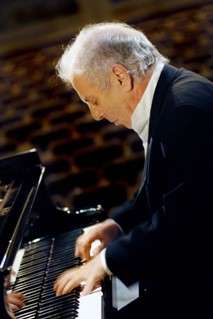|
Back
The Last Romantic New York
Isaac Stern Auditorium, Carnegie Hall
01/23/2017 -
Wolfgang Amadeus Mozart: Piano Concerto No. 26 in D major, K. 537, “Coronation”
Anton Bruckner: Symphony No. 4 in E-flat major, “Romantic”
Staatskapelle Berlin
Daniel Barenboim (piano and conductor)

D. Barenboim (© Monika Rittershaus)
“The Third symphony was completed on the last day of 1873. Two days later Bruckner began his Fourth. The flow of his lyricism was nearly constant...”
Jonathan D. Kramer, Listen to the Music
“…a sort of fabric that someone has woven with odd bits of thread chosen at random and coarsely knotted, without bothering about whether or not they blend in…”
Gustav Mahler, explaining his many cuts in the Bruckner Fourth Symphony
Bruckner’s “Romantic” Symphony was the first to achieve a resounding level of popularity. The composer, rather uncharacteristically, christened the piece with its soubriquet, which has stayed attached throughout its history. The Fourth was the first presented in America, in fact was mounted by two influential conductors here, Anton Seidl and Walter Damrosch, in the same year. Some of its appeal is centered around its exquisite tone painting, medieval tableaux of an excitingly evocative nature. Contemporary listeners may hear a bit of Game of Thrones in its regal and heraldic scenes.
The 4th is in many ways Bruckner’s most popular symphony. Musically literate little boys love it and, I would venture to state, it is programmed more often than any of his other efforts. Mahler was Bruckner’s star pupil and at 17 fashioned some of the two piano version of the Third Symphony (fellow student Rudolph Krzyzanowski constructed the finale), while later Bruno Walter was Mahler’s apprentice and arguably the greatest of all of the Bruckner conductors not of the Celibidache school, even when saddled with the “Columbia Symphony Orchestra”. The “Romantic” is the least revised of the group of nine, Bruckner rather unusually satisfied with this opus as is and posthumous generations rather fortuitously leaving it alone.
This was a splendid performance, the orchestra blended expertly to produce a palpably religious image, often echoing like an organ in full flight. The string sound was especially impressive, oozing through the hall and seeming to last, in the slower sections, just a bit longer than most readings would have been able to accomplish. Attention to detail was paramount – even the soft tympani sticks were clearly decided upon for their particular abilities to enunciate powerfully yet eloquently. For me, the highlight of the reading was the exquisitely drawn cadenza just before the conclusion of the slow movement, positively religious in nature. The Scherzo was eloquently reminiscent of the joust, a further touch of medievalism from this complex organist turned orchestral composer.
Once years ago I escorted a visiting ophthalmologist from Japan to a Beethoven concert wherein Mr. Barenboim both played and conducted. On the way home I mentioned that he was portrayed in the film Hilary and Jackie (about Jacqueline du Pré). “He’s that guy!?” my friend exclaimed, going on to say how much she hated him. With his back to the audience, he often seems to play by rote, taking no pains to make his keyboard artistry invested or interesting and can simply be dull and surprisingly colorless, almost as if he loses interest somewhere during the score (his listeners certainly do).
This concert series was meant to commemorate the pianist’s 60th year at the keyboard of Carnegie Hall. The question that came immediately to mind was hasn’t this fellow ever heard a period instrument performance during his tenure? The Mozart reading was positively laughable, the puppet-like jumpings up and down only adding to Mr. Barenboim’s seeming penchant for missed entrance notes, his reaching for the correct key mid-flail as he attempted to conduct a smaller band of musicians who were hardly even looking at him at any given moment. Too many wrong notes, a big overbearing instrumental sound, a mish-mosh of texture, a lack of delicacy. He reminded of Woody Allen’s Sleeper, still caught in a bygone era of orchestral and pianistic overtly aggrandized performance practice.
This nine-part series explores all of the sequentially numbered Bruckner symphonies, although ignores the zero and double zero entries. Each concert includes a Mozart opus as well, with Maestro Barenboim as soloist in the piano offerings, except for the presentation of the gargantuan 8th, which, because of length, will stand alone. Hmmm...I guess I’ll be back for that evening.
Fred Kirshnit
|